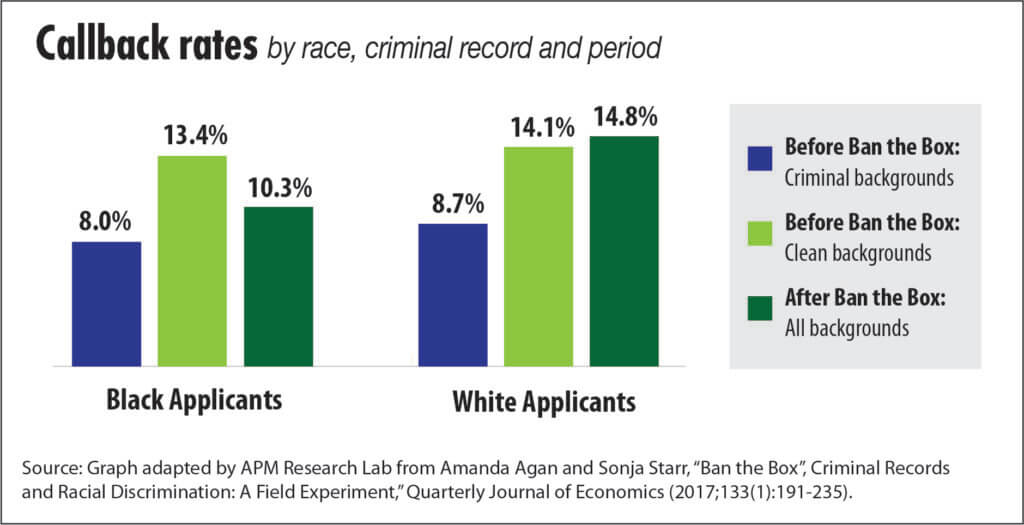Fair-chance hiring policies may hurt the job-seekers they aim to help
POLICY BRIEF | February 2019
Introduction
“Ban the Box” (BTB) policies have gained popularity as a method of attempting to ensure that individuals with criminal records get a fair shake from employers. With key political leaders, including Gov. Tony Evers, expressing support, BTB may see increasing discussion in Wisconsin.
While the goals of BTB policies are noble and reducing recidivism rates should be a priority, leaders should resist simple acceptance of BTB as a tried-and-true solution. Research suggests that BTB policies may help some but also hurt those with records more than they help and that the policies may have significant unintended consequences for younger, less-skilled minority men who do not have criminal records.
Ban the Box
In general terms, BTB policies forbid employers from asking on an initial job application whether an individual has been convicted of a crime. On many applications, conviction history is a box to be checked. Hence, the policy’s name.
Under BTB policies, it is only later in the hiring process — presumably after applications have been screened and the prospective employee has an opportunity to convey his or her qualifications to the employer — that an employer may inquire about relevant conviction history or run a background check.
The theory is intuitively appealing. It goes like this: When employers see an application with a criminal history, they too often throw it in the trash. As a result, qualified applicants with criminal records never get the opportunity to convey their value directly to employers. Because they never get in the door, they do not get hired.
So, eliminating a tool that employers use to immediately screen out those with convictions should increase the chances that qualified applicants with a conviction history get hired. This, in turn, should reduce recidivism rates. Since more individuals with conviction histories are earning legal, regular paychecks, their need or incentive to return to illegal activities for economic reasons is reduced.
The policies have proliferated at the federal, state and local levels. President Barack Obama banned the box in federal employment in 2015. By some measures, 33 states and 150 municipalities now have such policies in some form. In some areas, the policies are known as fair-chance laws. Most pertain to public-sector hiring. However, BTB policies have been extended in many states to the private sector as well.
Wisconsin has had BTB laws on the books since 2016. The 2015 Wisconsin Act 150 included provisions stating that the state may not “request a person applying for a position in the civil service, on an application or otherwise to supply information regarding the conviction record of the applicant or otherwise inquire into or consider the conviction record of the applicant before the applicant has been certified for the position.”1 Milwaukee in 2016 and Racine in 2017 passed similar local ordinances applying to civil service positions with those cities.2 As yet, these laws have not applied to private-sector employment in Wisconsin.
Do Ban the Box policies work?
Several recent and rigorous academic evaluations of these policies suggest that, at most, the policies do not appear to be effective at increasing employment levels among the formerly incarcerated. And many suggest that the policies have significant, unintended negative effects. Here is a selection.
► The racial gap in employer callback rates
A significant amount of research has documented that some level of discrimination occurs when employers review job applications — applicants with traditionally black names are less likely to receive employer callbacks than identical applicants with traditionally white names. Sonja Starr, a law professor at the University of Michigan, and Amanda Agan, a Princeton University economist, conducted a field experiment in New York and New Jersey to determine whether implementation of BTB in those jurisdictions affected this racial gap in callbacks.
They submitted applications from fictitious men in matched pairs based on race — black and white — by assigning distinctly black or distinctly white names to the fictitious applicants. They then randomly assigned to these applications a felony conviction or no record. They submitted the matched applications to the same employer with order randomized and time lag. They then tracked the percentage of those fictitious résumés that received callbacks from employers before and after the jurisdictions implemented BTB.
The authors found that before BTB, and among employers affected by the laws, white applicants received 7 percent more callbacks than matched black applicants. However, after BTB went into effect, and among this same group of affected employers, this racial callback gap increased dramatically — to 43 percent. While the results do show that callback rates for black men with criminal records increased following TBT, the authors indicate that:
“The post-BTB increase in racial inequality in callback rates appears to come from a combination of losses to black applicants and gains to white applicants. In particular, black applicants without criminal records saw a substantial drop in callback rates after BTB, which their white counterparts did not see. Meanwhile, white applicants with criminal records saw a substantial increase in callbacks, which their black counterparts did not see. This pattern suggests that when employers lack individualized information, they tend to generalize that black applicants, but not white applicants, are likely to have records.”3
The accompanying chart, from the APM Research Lab, presents the findings in another way.4

This appears consistent with other research on statistical discrimination. Harry Holzer of Georgetown University, Steven Raphael of the University of California-Berkeley and Michael Stoll of UCLA find the same thing — just in reverse. They found that “employers who check criminal backgrounds are more likely to hire African-American workers, especially men. This effect is stronger among those employers who report an aversion to hiring those with criminal records than among those who do not.” They note that “in the absence of criminal background checks, some employers discriminate statistically against black men and/or those with weak employment records.”5
► Employment among less-skilled minority men
Texas A&M University economist Jennifer Doleac and University of Oregon economist Benjamin Hansen took a slightly different approach to their evaluation of the effects of BTB laws. They exploited differences in the structure and implementation of these policies across states to determine what effect the policies had on actual employment, not just callback rates or inequities.
Their research found that BTB reduced the probability of employment by 3.4 percentage points for younger, less-skilled black men and by 2.3 percentage points for younger, less-skilled Hispanic men. The effects persisted for black men long after the policy change, and the effects were “larger for the least skilled in this group (those with no high school diploma or GED), for whom a recent incarceration is more likely.”

The accompanying chart from their paper compares changes in the probability of employment for black and Hispanic men ages 25 to 34 with no college degree, based on whether or not the jurisdiction adopted BTB laws. The orange line tracks employment probabilities for those that adopted BTB; the blue line shows trends for jurisdictions that did not adopt BTB. MSA stands for metropolitan statistical area.
The authors put it bluntly: “We find evidence that BTB has unintentionally done more harm than good when it comes to helping disadvantaged job-seekers find jobs.”6
This aligns logically with another interesting study the authors cite about statistical discrimination, drug testing and black employment. Abigail Wozniak of the University of Notre Dame found that with respect to drug testing, “adoption of pro-testing legislation increased black employment in the testing sector by 7-30% and relative wages by 1.4-13%, with the largest shifts among low-skilled black men.”7
In the absence of information, employers statistically discriminated against the groups they perceived to use drugs at higher rates. The same appears to be the case here, but for conviction history.
► Employment among ex-offenders
A study conducted by Osborne Jackson and Bo Zhao of the Federal Reserve Bank of Boston focused directly on those with criminal records. The study examined employment records of individual people who had criminal records and presumably would be helped by a change in Massachusetts policy in 2010-2012.
That policy contained two components. First, it applied BTB restrictions for both private- and public-sector employers. Second, it limited the amount of information available to employers about criminal histories in its Criminal Offender Record Information database.
If these policies worked as intended, one would expect that the gap in employment rates between ex-offenders and the general population would narrow. The authors found that relative to the broader population, employment among ex-offenders post-BTB declined roughly 2.6 percentage points. The records reforms had a modest negative reduction of about 0.46 percentage points in employment.
Counterpoint?
No public policy issue would be complete without some apparently conflicting evidence.
One recent example comes from Daniel Shoag of Harvard University’s Kennedy School and Stan Veuger of the American Enterprise Institute. They examined BTB effects at the neighborhood level. They sought to understand employment effects of the policy in high-crime neighborhoods in response to implementation of BTB — which would seem consistent with the objectives of the policy.
They found that the top quarter of high-crime neighborhoods saw a 4-percentage-point increase in employment following implementation of BTB, noting that gains were concentrated in public-sector and low-wage jobs.
Interestingly, they also found that the gains “do not represent aggregate employment gains, but rather substitution across workers.” Employers, they found, responded to this policy shift by raising the educational qualifications required for jobs, perhaps as a screening proxy for employee quality in the absence of criminal history questions.
Their findings contradicted the previously described research — they found that black men benefit, but black women are worse off. This, they suggest, is because black women are less likely to have been convicted of a crime than black men — so when convictions are used less to screen out applicants, the advantaged position that black women previously enjoyed is reduced.8
Discussion
Policy-makers should use caution and consult rigorous academic research when considering issues as important as BTB policies and that have as much intuitive appeal. Though well-intended, and potentially beneficial for some, strong evidence indicates that BTB can reduce employment among young minority men with no criminal records as well as those with criminal records.
But there is also evidence that high-crime neighborhoods may benefit and that black men in those neighborhoods benefit while women in those neighborhoods are made worse off. It could be that both are true — for example, that those with criminal histories and less-skilled minority men in lower-crime neighborhoods are worse off on average, and especially worse off in lower-crime neighborhoods than they would have been without BTB, but also that those in the highest-crime neighborhoods are better off. Or, it could be that older black men are made better off, while younger minority men are worse off.
These are areas for research and careful public policy discussion. For example, would it be worth increasing employment in the highest-crime neighborhoods if doing so makes less-skilled minority men with no criminal record and those with criminal records worse off overall, as well as black women in the highest-crime neighborhoods? The point is that BTB policies are not costless panaceas that make everyone better off.
Perhaps there are more effective, targeted ways of addressing the barriers to employment faced by those with criminal records. Take certificates of qualification for employment (CQE), for example. If a judge makes the determination that an individual has demonstrated rehabilitation and work-readiness, the court issues a certificate saying so.
The theory is that by presenting this certificate to an employer, applicants with criminal records signal that they are ready to work, offsetting concerns an employer may have with their criminal history. This can be paired with policy that eliminates liability for an employer — another of their concerns — if they hire someone who has presented a certificate. If a court has said that person is ready for work, why should the employer be sued for negligence in hiring?
Peter Leasure of York College of Pennsylvania and Tia Stevens Andersen of the University of South Carolina tested this idea. They created job applications and randomly assigned either a clean record, a felony conviction, or a felony conviction with CQE.
The results? Those with CQE were called back at roughly the same rate as those with no felony conviction, while those with a felony conviction but no CQE were called back at much lower rates.9
Under Ban the Box policies, some groups appear to be made worse off, while others may modestly gain. At a minimum, policy-makers should not gloss over focused discussion and honest weighing of these significant trade-offs — more harm than good could easily be done.
Perhaps there are better approaches that involve fewer trade-offs.
Endnotes
1 https://docs.legis.wisconsin.gov/2015/related/acts/150/31
2 https://www.natlawreview.com/article/wisconsin-racine-bans-box-civil-service-applications
3 Agan, Amanda, and Sonja Starr. 2018. “Ban the Box, Criminal Records, and Racial Discrimination: A Field Experiment.” Quarterly Journal of Economics, 133
4 https://www.apmresearchlab.org/stories/2018/05/16/ban-the-box-may-be-counterproductive
5 Harry J. Holzer, Steven Raphael and Michael A. Stoll, “Perceived Criminality, Criminal Background Checks, and the Racial Hiring Practices of Employers,” The Journal of Law and Economics 49, no. 2 (October 2006): 451-480.
6 http://jenniferdoleac.com/wp-content/uploads/2015/03/Doleac_Hansen_BanTheBox.pdf
7 Wozniak, A. (2015). Discrimination and the effects of drug testing on black employment. Review of Economics and Statistics, 97(3):548–566
9 Leasure, Peter, and Tia Stevens Andersen. 2016. “The Effectiveness of Certificates of Relief as Collateral Consequence Relief Mechanisms: An Experimental Study.” Yale Law & Policy Review Inter Alia, 35(11): 11-22.




